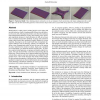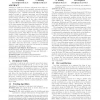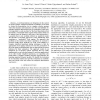716 search results - page 124 / 144 » On Graphical Modeling of Preference and Importance |
TOG
2008
13 years 8 months ago
2008
Knitted fabric is widely used in clothing because of its unique and stretchy behavior, which is fundamentally different from the behavior of woven cloth. The properties of knits c...
SIGSOFT
2001
ACM
14 years 9 months ago
2001
ACM
Prior research in software environments focused on three important problems-- tool integration, artifact management, and process guidance. The context for that research, and hence...
WWW
2006
ACM
14 years 9 months ago
2006
ACM
The asymmetry of activity in virtual communities is of great interest. While participation in the activities of virtual communities is crucial for a community's survival and ...
KDD
2008
ACM
14 years 8 months ago
2008
ACM
Learning to rank from relevance judgment is an active research area. Itemwise score regression, pairwise preference satisfaction, and listwise structured learning are the major te...
ICRA
2008
IEEE
14 years 2 months ago
2008
IEEE
— Local linearizations are ubiquitous in the control of robotic systems. Analytical methods, if available, can be used to obtain the linearization, but in complex robotics system...



